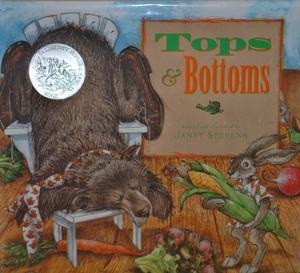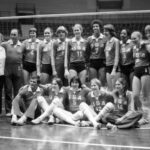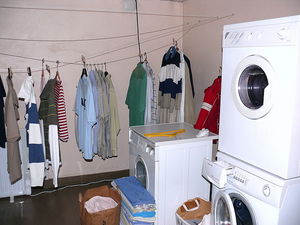The children’s book Tops and Bottoms, adapted and illustrated by Janet Stevens, was one of the winners of the Caldecott Honor Medal in 1996. The storyline is drawn from European folktales and slave stories of the American South, in which the trickster tradition is celebrated as a main character overcomes hardship (and powerful figures) by using his wits. Stevens is best-known for her illustrations of animals as well as her award-winning pictures of vegetables.
Several aspects of book and its illustrations allow for the child reader to make a connection to the storyline and to the title, Tops and Bottoms. First, children can make a psychological connection to the title because the book and its pages open from bottom to top instead of right to left. Also, the title page helps kids make a visual connection to the title. This page treats the crease of the two-page spread as the ground level and illustrates for children some vegetables and which parts of the vegetables grow above ground and which grow below ground. The vegetables that grow below ground (like carrots and radishes) are drawn below the crease at the center of the two pages while the stalks of these vegetables shoot up on the top page from the crease. The opposite is illustrated for the vegetables that grow above ground (like lettuce).
Second, the animal characters (Bear and the rabbit family) are typically placed on the top or bottom pages according to what is occurring in the story at the time. For example, when Hare and Bear made their first agreement that Hare would get the bottoms and the Bear would receive the tops, the following pages showed the rabbit family doing all the hard work on the bottom page while Bear slept on the top page. The same structure is true for the second agreement. Hare and his family, who would get the tops, did all the labor on the top page; meanwhile Bear, who would receive the bottoms, slept on the bottom page. For the third agreement, Bear was illustrated on both the top and the bottom page when he was going to receive both the tops and the bottoms.
Finally, the story involves two types of animals-a bear and a family of rabbits-one of which lives above ground and the other lives underground. This choice in animals obviously relates to the title, but it also has a deeper meaning. In the story, the seemingly more inferior characters are the rabbit family, who live in a simple hole underground that might signify a less powerful or even “slave” status. However, the bear lives in a nice house above ground, he owns all of the surrounding land, and he is seen as the more powerful creature under whom the rabbits work.
Stevens’ decision to put clothes on the animal characters and to have Bear live in a house allow for children to easily relate to the characters in the story. Children can also relate to the characters due to other aspects of the plot and illustrations, such as the large size of the rabbit family, the poor status of the rabbit family, the wealthy status of Bear, and the value of work. The animal characters are personified by their clothes. Hare wears a shirt, which happens to have carrot designs on it; Bear wears a tie and shoes that are unlaced until the last page. The designs on Bear’s tie are ironic to Bear’s lazy attitude because bees are hard-working insects. However, the bees could also be a parallel to Bear’s quick temper, since bees also tend to have quick tempers. The illustrations that show how the animals live like humans, or that they at least live by the same principles, may seem both intriguing and silly to children.
Many of the pictures look like they are painted from the hare’s point of view with the big bear always looming over them. This perspective emphasizes the idea of size signifying amount of power. Despite Bear’s large size and Hare’s small size, the hare is able to outwit Bear and bring down his lazy attitude a couple notches such that Bear is provoked into doing his own labor. The lesson for children here is that hard work, or a good work ethic, pays off while laziness does not.
The second full spread of pages in the book shows the rabbit family in their small hole. Through this hole, we see the rabbits’ perspective of Bear, his large house, and his most attractive-looking expanse of unused cropland. Stevens’ use of human items within the rabbit family’s home also helps children to relate to the characters. Some of these items include a table and cloth, candle, newspaper, and a shoe that is probably used for a bed.
The painted pictures create vibrant illustrations that attract attention effectively. Stevens’ animals are endearing in the way they are depicted with real-looking fur, human-like and comical facial expressions, and their few articles of clothing. The vegetables illustrated in this book, like the pile of carrots and radishes, look 3-D and lifelike. The text is placed in boxes that are overlapped onto the pictures, which might give the impression that this story and its illustrations work together.
None of the text is a special font, nor is any of the text altered throughout the story except the first letter of the first word of the story: the “O” in the word “Once” is replaced by a radish. This feature, in addition to the end pages of the book, emphasizes the role of vegetables in the story. The end pages are decorated with various illustrations of vegetables floating around on the pages against an earthy-colored background. The text within the story and the illustrations both teach children what different vegetables look like, which parts are edible, and how these vegetables grow.
This story is about the change in relationship between two polar-opposite characters, and how Bear learns a lesson while Hare overcomes hardship. In the beginning of the story, Hare’s family appears to be unmanageable with so many children and so little food. As the story progresses, Bear’s house becomes more and more degraded as Bear continues to sleep, neglect his house, home, and land. Children will probably notice as the pages keep turning that more of the shutters on Bear’s house fall off. In the last spread of pages, Bear has learned his lesson and is now grumpily doing his own labor. We see the fruits of labor in his renewed house and land: the wheelbarrow is right-side up, a shovel leans neatly against the side of the house, his shoelaces are tied, and all the shutters are fixed back onto the house.
The last spread of pages show the fruits of the rabbit family’s hard labor: the family is happy, appears less chaotic (more manageable), surrounded by plenty of food, and working their own vegetable stand business. Also on this last spread of pages is a fence that runs along the crease between the top and bottom page that separates the neighbors (Bear and Hare). This physical barrier between the neighbors portrays the rabbit family’s freedom from living in debt to Bear (like slaves who have gained their freedom); meanwhile the fence could also be illustrating the idea that “Good fences make good neighbors.”
Janet Stevens’ illustrations are effective and attractive such that the story could be told without the text. Her vibrant color pallet and dynamic animal characters appeal to the child reader both for instruction and entertainment.
Works Cited
Stevens, Janet. Tops and Bottoms.
San Diego
: Harcourt Brace & Company, 1995.




